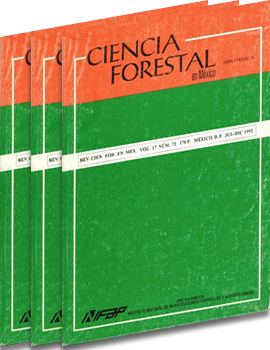EVALUACIÓN DEL CONTROL DE Dendroctonus mexicanus MEDIANTE LA FUMIGACIÓN CON FOSFAMINA
Keywords:
Bark beatle, Forest Entomology, forest pests, chemical controlAbstract
Of insects attacking various pine species in Mexico, the bark beatle Dendroctonus mexicanus Hopkins is thought to be the main pest given its distribution and the damages it causes. To reduce the damage of this pest, it was recently proposed to fumigate infested areas by using phosphamine derived as a gas from aluminum phosphide tablets.
However, the lack of elements to decide on the optimum dosis, safety limitations and the lack of data to manage this pesticide prompted this study to determine the mortality rates in mature and immature stages of D. mexicanus fumigated with phosphamine as well as the L D 50 and L D 95 doses and the effect of this gas on natural enemies.
The study was conducted in june, 1989 in Pinus leiophylla forests of El Tigre mountains in Gomez Farias, Jalisco.
The experimental design used was of random blocks arrayed in divided parcels with four fumigation doses, three exposure times and five repetitions.
The results showed that the three and five tablet doses had the highest rates with the
D. mexicanus population. L D 95 for exposure times of 3, 5 and 7 days. was 158, 115, and 97 g ofphosphamine per m3 ofwood, respectively.
As to the beneficial entomofauna, the results showed that every lethal dose for the pest population was also lethal for natural enemies.
Downloads
Downloads
Published
How to Cite
Issue
Section
License
The authors who publish in Revista Mexicana de Ciencias Forestales accept the following conditions:
In accordance with copyright laws, Revista Mexicana de Ciencias Forestales recognizes and respects the authors’ moral right and ownership of property rights which will be transferred to the journal for dissemination in open access.
All the texts published by Revista Mexicana de Ciencias Forestales –with no exception– are distributed under a Creative Commons License Attribution-NonCommercial 4.0 International (CC BY-NC 4.0), which allows third parties to use the publication as long as the work’s authorship and its first publication in this journal are mentioned
The author(s) can enter into independent and additional contractual agreements for the nonexclusive distribution of the version of the article published in Revista Mexicana de Ciencias Forestales (for example, include it into an institutional repository or publish it in a book) as long as it is clearly and explicitly indicated that the work was published for the first time in Revista Mexicana de Ciencias Forestales.
For all the above, the authors shall send the form of Letter-transfer of Property Rights for the first publication duly filled in and signed by the author(s). This form must be sent as a PDF file to: ciencia.forestal2@inifap.gob.mx
This work is licensed under a Creative Commons Attribution-Noncommercial 4.0 International license.


